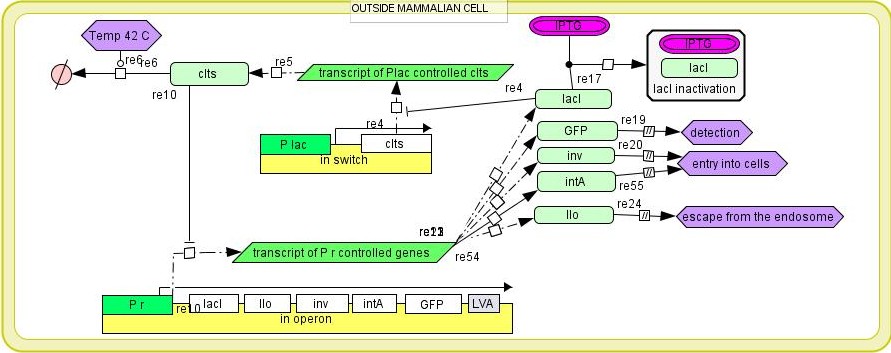Team:Warsaw/Project/invasion
From 2009.igem.org
(→Entrance of bacteria into eukaryotic cells) |
|||
| Line 3: | Line 3: | ||
==Entrance of bacteria into eukaryotic cells== | ==Entrance of bacteria into eukaryotic cells== | ||
| - | The main aim of our project is to make, using synthetic biology methods, ''Escherichia coli'' capable of entering mammalian cells. We've decided to use proteins used in the same manner by enteropathogenic species like ''Listeria'' sp. or ''Yersinia'' sp. (see [https://2009.igem.org/Team:Warsaw/Biosafety safety] page for details about safety issues) | + | The main aim of our project is to make, using synthetic biology methods, an ''Escherichia coli'' capable of entering mammalian cells. We've decided to use proteins that are already used in the same manner by enteropathogenic species like ''Listeria'' sp. or ''Yersinia'' sp. (see [https://2009.igem.org/Team:Warsaw/Biosafety safety] page for details about safety issues) |
| - | + | ||
==Theoretical basis== | ==Theoretical basis== | ||
Revision as of 18:02, 21 October 2009
Contents |
Entrance of bacteria into eukaryotic cells
The main aim of our project is to make, using synthetic biology methods, an Escherichia coli capable of entering mammalian cells. We've decided to use proteins that are already used in the same manner by enteropathogenic species like Listeria sp. or Yersinia sp. (see safety page for details about safety issues)
Theoretical basis
Many bacterial species are capable of entering mammalian cells. One of the crucial proteins for this process is invasin. It is capable of selective interaction with integrins, which are present on external eukaryotic membrane. This triggers signalling cascade, indispensable to start endocytosis [9]. This interaction occurs via the invasin N-terminal domain, which is capable of promoting effective endocytosis of bacteria that synthesize invasin by cells normally unable to undertake phagocytosis [3]. The other protein which is involved in process of entering mammalian cells is internalin, which can be found on the surface of Listeria monocytogenes. Internalin is selecively interacting with cadherins found on the external eukaryotic membrane.
Details
Invasion process
Invasion process has to be driven by 2 proteins: invasin from Yersinia sp. or InternalinA from Listeria monocytogenes. In a presence of listeriolysin from Listeria monocytogenes both proteins should effectively bind to surface of mammalian cells and trigger internalisation of whole bacteria. We would like to test both invasin and InternalinA and test which one is the most effective.
Listeriolysin will be fused with secretion system because, in the opposite to invasin and internalinA, it doesn't contain its own secretion signal. Listeriolysin is also important for the next step of invasion - escape from the endosome.
Regulation
Our invasion module is controlled by a bistable switch, composed by 2 promoters and 2 repressors. Invasion proteins are under control of bacteriophage promoter (pR) that is repressed by cI protein. The second part of the operon is gene cIts that encodes for thermosensitive version of the cI repressor protein from phage λ. It is under the control of lactose promoter (Plac). This λ system of promoters and regulatory genes creates two mutually exclusive negative feedback loops and is dubbed the bistable switch [19]. It has two states depending on conditions within the cell. cI protein binds the PR promoter inhibiting its activity and expression of the invasion operon genes. cIts protein is inactivated by high temperature 42°C what allows the expression of invasion operon that codes for lacI. lacI stops gene expression from the Plac promoter ( the expression of cI protein). IPTG that binds and inactivates lacI can be used to switch on the expression from Plac promoter. Another way to control the operon is in trans expression of cI or lacI genes. Activated invasion operon causes internalisation of bacteria by mammalian cells. Expression of green fluorescence protein allows observation of the process using fluorescence microscopy.

Fig 2. The overview of the invasion operon. It is based on a lacI/cI bistable switch. After thermal activation (42°C) the expression of genes that enable invasion of mammalian cells is activated. The invasion operon is composed of lacI – lactose operon repressor, llo – hemolysin from Listeria monocytogenes, inv – invasin from Yersinia sp., GFP – Green Fluorescent Protein from Aqueora victoria.
The invasion operon includes lacI– lactose operon repressor, llo – hemolysin from Listeria monocytogenes (listeriolysin), inv – invasin from Yersinia sp., GFP – green fluorescent protein. (Fig.2.). These genes are under the control of bacteriophage promoter (PR) that is repressed by cI protein. The second part of the operon is gene cIts that encodes for thermosensitive version of the cI repressor protein from phage λ. It is under the control of lactose promoter (Plac). This λ system of promoters and regulatory genes creates two mutually exclusive negative feedback loops and is dubbed the bistable switch [19]. It has two states depending on conditions within the cell. cI protein binds the PR promoter inhibiting its activity and expression of the invasion operon genes. cIts protein is inactivated by high temperature 42°C it allows the expression of invasion operon that codes for lacI. lacI stops gene expression from the Plac promoter ( the expression of cI protein). IPTG that binds and inactivates lacI can be used to switch on the expression from Plac promoter. Another way to control the operon is in trans expression of cI or lacI genes. Activated invasion operon causes internalisation of bacteria by mammalian cells. It also detects endosomal localisation using PhoP/PhoQ system. Expression of green fluorescence protein allows observation of the process using confocal microscopy.
Tutaj bedzie potrzebny jakiś obrazek skupiający się tylko na inwazyjności... (schemacik)
 "
"
